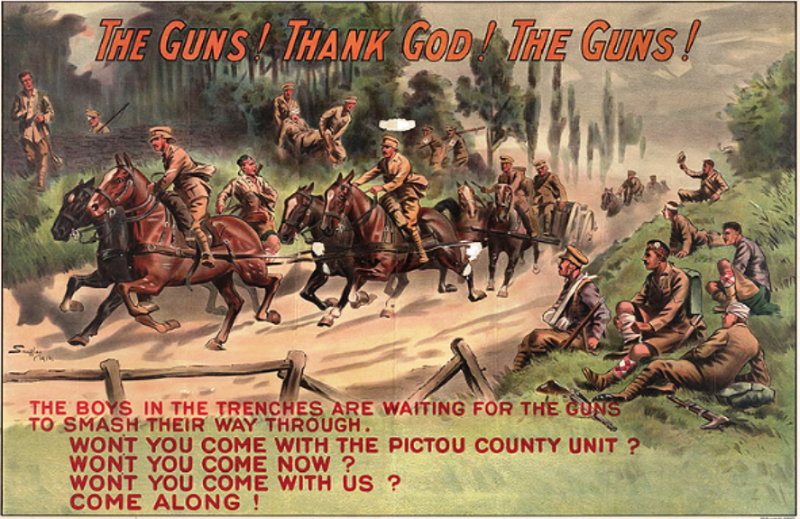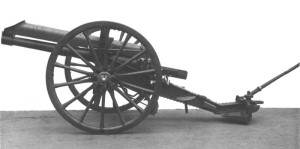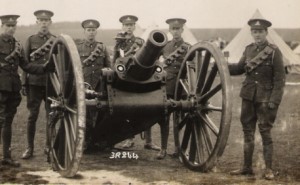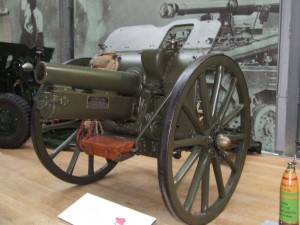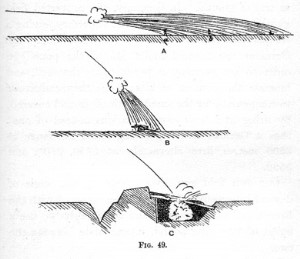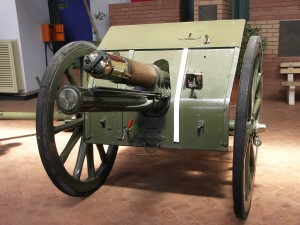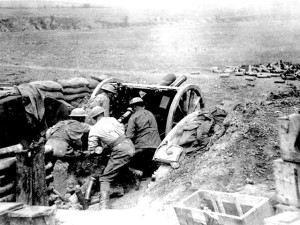Territorial Gunners
Ubique - Territorial Gunners – Rounds on Belgian Ground
An abbreviated version of the article appeared in Volunteer Magazine No. 103, Winter 2015 (the magazine the RFCA for North West England and the Isle of Man)
A Canadian recruiting poster shows a romantic vision of an 18-pounder gun team galloping into action. It is a much simplified version of the picture by Snaffles (Charlie Johnson Payne) 'The Guns! Thank God! The Guns!', a line taken from a poem by Rudyard Kipling. (Courtesy of the Nova Scotia Archive ©)
In previous articles we have looked at the reservist contribution of the Territorial Force infantry units in the First World War and, more recently, that of the Royal Engineers. In this article we look at the contribution of some of the North Western Territorial gunner units of the Royal Field Artillery.
Ubique means that warnin’ grunt the perished linesman knows,
When o’er ’is strung an’ sufferin’ front the shrapnel sprays ’is foes;
An’ as their firin’ dies away the ’usky whisper runs
From lips that ’ave n’t drunk all day: “The Guns! Thank Gawd, the Guns!”
Rudyard Kipling (1903)
Writing shortly after the South Africa’s Boer War, Kipling’s verse uses the sole battle honour of the Royal Artillery, ‘Ubique’ meaning ‘Everywhere'1to start this verse about how the sound of the guns (‘the warnin’ grunt’) provides hope to the ‘linesman’ (an infantryman rather than a signaller) under fire. Artillery support remains as crucial and valued today at the time of the Great War and then, as now, the Reserve contribution was crucial.
Small Guns, Big Guns, Field Gunners and Garrison Gunners, Territorials and Regulars
When the Territorial Force (TF) formed in 1908 from the old Volunteers, there were essentially three branches of the RA. The Royal Horse Artillery (RHA) had light guns such as the 12 pounder to support and move with cavalry. The Royal Field Artillery (RFA) was armed with field guns to give close and rapid support to the infantry and its units were called ‘brigades’. An artillery brigade was the equivalent of an infantry, commanded by a lieutenant-colonel. In 1908 the Regular Army RFA was equipped with 18 pounders and 4.5 inch howitzers whilst the TF field gunners were initially issued with obsolescent 15 pounders and 5 inch howitzers as a cost-saving measure. The howitzers fired a heavier shell at a greater angle. RFA ‘brigades’ were normally an integral part of the structure of an infantry division for the early part of the war: later some were detached to be used more flexibly allowing them to be switch across different corps and armies.
The third branch was the Royal Garrison Artillery (RGA) which manned heavy guns such as the then-modern 60 pounder. The TF RGA got the obsolescent and cumbersome long-barrelled 4.7 inch gun used until the barrels became so worn with firing (quite early in the war) that they became grossly inaccurate and unpredictable when they were gradually replaced. Ordnance (what gunners sometimes call ‘guns’ when they want to sound technical and informed) such as this would be used for work against deep entrenchments, enemy artillery batteries (counter-battery or ‘CB’ tasks), fortifications (siege artillery) and also coastal artillery. The RGA would often be controlled at corps or army level rather than at divisional level.
The 15-pounder field gun used by the Territorial Force at the start of WW1 with a range of 5750 yds (5250 m) until replaced by the 18-pounder
Territorial Gunners in North West England
Across the North West many of the pre-1908 Volunteer units became units of either the RFA or the RGA. For instance, the Cumberland RGA (Volunteers) became part of the 4th East Lancs Brigade in the TF and four brigades of the RFA were formed in each of East Lancashire and West Lancashire with names such as the Manchester Artillery and the Bolton Artillery. The pre-1908 Cheshire RGA was succeeded by units that formed part of the 3rd Welsh Brigade RFA. Heavier TF support came from the units titled as the East Lancs RGA and the West Lancs RGA whilst a unit known as the ‘Lancashire and Cheshire RGA’ manned the Mersey Defences at places such as Fort Perch Rock on New Brighton seafront opposite Liverpool. The Fort had the distinction of firing, under the command of Captain Luya (a local Territorial officer and a dentist), two very early British shots of the Great War when a Norwegian vessel under sail failed to obey a signal from the fort. The first round landed (fairly) harmlessly near Altcar Ranges on the other side of the river the second struck the hull of a merchant steamer. The ship’s captain did not realise that a war had started. There is no record of a Territorial unit of the Royal Horse Artillery in the North West of England: perhaps the dark satanic industrial nature of the area was not suited to the dash, style and élan of the horse gunners.
The 5 inch howitzer with range of the Mark II 6500 yds (5900 m) with a 40 pound shell and was used by the TF RFA in WW1 until replaced by the more modern 4.5 inch howitzer. It is seen here, probably with Warwickshire Territorials, pre-war.
The 4.5 inch Howitzer issued to some Territorial brigades of the RFA during WW1 to replace the 5 inch howitzer. The Mark II had an effective range of Mk II: 7,300 yd (6,700 m) and it could fire a shrapnel round or a High Explosive round. Fired at a relatively high angle, HE shells and shrapnel were more able to drop into entrenchments and other fortification than rounds from a low angle 18-pounder.
Photo: Rob Langham
In an infantry division such as the West Lancs Division (later the 55th Division) there were three RFA ‘brigades’ of 15-pounders, later 18 pounders. Each ‘brigade’ would typically have three batteries of four guns each (later increased to six guns, giving fifty-four 18-pounders to each division if at full strength). The RFA in each division would also have a fourth ‘brigade’ of howitzers made up of two batteries armed with either the 5 inch or the more modern 4.5 inch howitzer.
Ranges and Ammunition
The ranges of these guns were typically between 6000 and 7500 metres (see inset). At this time the British were pre-occupied with shrapnel rounds rather than high explosive. A shrapnel round for the standard 18-pounder contained 374 lead bullets (like musket balls – see illustration). Using a time fuze, these would be blown out of the front of the shell (a shrapnel ‘pot’) at some point late in its flight in a conical pattern. The 18 pounder had a very flat trajectory (path of the shell) and so the shrapnel balls very effectively swept anything in front of it on open ground. This was ineffective against men in dugouts and trenches. For that task, high explosive (HE) was needed. At the beginning of the war, there was no HE round for the 18-pounder: this only appeared later. This yawning gap in the RFA capability was partially covered by the 4.5 inch howitzer that had a high trajectory and could bring fire down onto trenches. It also had a limited number of HE shells. Until instantaneous fuzes were developed later in the war (a very significant technological development), HE shells tended to dig into the ground before exploding, making them less effective and causing shell holes that badly held up future advances of both men and guns. The 106 fuze, developed apparently from French technology, would explode a shell on impact with barbed wire. The ability of gunfire to cut barbed wire entanglements generally depended on the scatter of shrapnel balls rather than an explosion beneath the wire. When the instantaneous fuze was developed, HE came to be used for wire cutting; fragments of the shell case would cause the necessary damage rather than shrapnel balls.
A low angle path allows shrapnel tio project forward over a large area of open ground. A shell coming at a high angle (as from a howitzer) sprays shrapnel over less ground but into the bottom of trenches and can drop HE onto targets behind a parapet.
 A cut-away representation of an 18-pounder shrapnel shell, usually fired at a low angle, with 384 lead-antimony bullets that would be projected forward late in the flight in a conical pattern to clear open ground.
A cut-away representation of an 18-pounder shrapnel shell, usually fired at a low angle, with 384 lead-antimony bullets that would be projected forward late in the flight in a conical pattern to clear open ground.
Firing from the Hip or First Time Rounds on the Target from the Map?
In 1914, technical gunnery was not good. In the RFA, the principle seemed to be to make guess as to how to aim the guns and then fire lots of shells, look to see where they landed and then change the aim until they got it right. Carefully predicted fire was not in fashion and in many cases, the guns were run so far forward that they could directly observe their targets. At the Battle of Le Cateau in 1914, the regular gunners were only some hundreds of yards behind the infantry front line and suffered severe losses in both men and guns as a result: it was almost like gunnery at the Battle of Waterloo 99 years before. There was little concern for precise prediction in the RFA. According to historian Sanders Marble in The Infantry Can Do with Not a Gun Less, an RGA major was publically laughed at during an important meeting at for suggesting that gunners needed to take wind speed and air temperature into account to get rounds on the ground at the first attempt. ‘In other words, the best thing to do was blaze away and correct your fire as you went rather than bothering to try and hit with the first shells.’
The RGA, the Garrison gunners with heavier weapons, took more care to calculate and began to take into account air pressure and temperature, wind speed and barrel wear, techniques that spread across the whole of the artillery, Regular and Territorial gunners alike, as the need for pinpoint accuracy developed. These skills were combined with technical developments such as sound-ranging, aerial photography and the correction of fire from aircraft and tactical developments such as the creeping or timed barrage (borrowed from the French) allowed much better support of infantry. By the Battle of Cambrai in November 1917, the artillery achieved surprise by successfully putting down the first rounds of its devastating bombardment without having signalled its intention with lengthy ranging shoots. This was perhaps more significant (but less dramatic) than the use of tanks in the same battle.
In parallel with developments in technique, the supply of ammunition improved both in terms of quantity and quality. In 1915, the so-called ‘shell crisis’ materialised. The armaments industry was not geared to the very rapid expansion of demand that a long war and its increased reliance on intensive artillery bombardment had created. Attacks were seen to fail for want of shells and the factories could not produce enough. This had a seismic effect of the British Government, brought David Lloyd George to the post of Minister for Munitions and eventually led to a coalition government. Lloyd George took a lot of credit for improving munition supply although it is likely that some of the decisive action had already been set in train before he took up his new office but that certainly did not prevent Lloyd George from allowing himself to be painted as the hero of the hour which in turn did him no harm when he was appointed as Prime Minister later in 1915.
It was not simply a matter of numbers of shells but also of their quality. Precision of weight and dimension was required to ensure that each shell would behave in the same way to land where intended and considerable skill in machining was needed to ensure that fuzes worked reliably. The fields of France and Belgium are still today littered with dangerous unexploded shells, the result possibly of a soft landing but often of a careless or unskilled munitions worker. An inspection system was set up to raise quality and reliability.
Experience of the West Lancashire Gunners
Against this background the Territorial gunners of Lancashire were getting on with the war. They had a lot to learn … and quickly.
The East Lancashire gunners from Blackburn, Burnley and Bolton joined the 42nd Division on Gallipoli in September 1915 and the Manchester Artillery arrived in Egypt in May from Britain and remained there.2
There were four brigades of the West Lancs RFA. The 1st Brigade and 4th Brigades were based near the centre of Liverpool, the 2nd Brigade was based in Preston, Lancaster and Blackpool and the 3rd Brigade was based around Toxteth (south Liverpool) with a battery at Widnes.
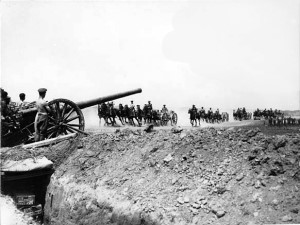 The 4th West Lancashire Brigade of the RFA started the war with the 5 inch howitzer. Their immediate Volunteer predecessors had used muzzle-loading 40-pounders similar to old-fashioned cannons; having a breech-loading gun in 1908 was, they thought, a significant step forward. On mobilization in Liverpool, almost the first thing to happen was that the Regular Army pinched 100 of their horses to go to France. To resolve the equine shortage:
The 4th West Lancashire Brigade of the RFA started the war with the 5 inch howitzer. Their immediate Volunteer predecessors had used muzzle-loading 40-pounders similar to old-fashioned cannons; having a breech-loading gun in 1908 was, they thought, a significant step forward. On mobilization in Liverpool, almost the first thing to happen was that the Regular Army pinched 100 of their horses to go to France. To resolve the equine shortage:
Eventually a party of officers was sent to the Isle of Man and returned triumphant with the pick of the famous Douglas tram horses … Six mineral wagons and pairs [of horses] were requisitioned for the Brigade Ammunition Column … their drivers decided to enlist en masse [as they no longer seemed to have a civilian future]
(4th WL RFA History)
This possibly detracted from the pleasure of late holidaymakers on the Douglas promenade but made for happier Liverpool gunners. They trained in England, at Liverpool and Canterbury, putting up with the usual wild scare stories of invasions and spies.
The Brigade was told not to fire at strange aircraft that might be searching for a [concealed German Zeppelin airship base] in the Lakeland or the Peak District.
(4th WL RFA History)
The infantry battalions of the West Lancashire Division were sent one by one to France and Flanders but the gunners remained in south east England until, in September 1915, all the West Lancashire RFA brigades were placed under orders to join the 2nd Canadian Division in Belgium. After months of training with their obsolescent weapons, they were suddenly issued with the up-to-date 18-pounder and 4.5 inch howitzer. These new and unfamiliar guns were in use against the enemy within days of joining the Canadian division in early October. Some sailed to Le Havre on an Isle of Man steamer, Mona’s Queen, but ‘it was no pleasure trip; the ship was crowded and the sea choppy’. It took 12 hours in the rain to get off the boat.
[They marched to] a rest Camp which was a sea of mud. There were no lights, no tent boards and no food, except a scant supply of ‘bully’3The men … found the canvas tents leaked. … But the horses were the worst sufferers … [tethered] in deep mud in a biting wind and pouring rain, with all their harness on [as it could not be laid on the mud].
(4th WL RFA History)
A couple of days were devoted to trying to get clean again. The men soon learned to augment the ordinary rations by means of egg and chips, and settled down at once to this strange life in a foreign country.
(Wadsworth, 1st WL RFA)
The 18-pounder, the standard field gun of WW1. The barrel is below the ‘recuperator’ of the recoil mechanism. The early versions had a range of 7800 yds (7100 m) and 9,300 with the trail dug in. Later versions fired to 11,100 yds. The gun could fire up to 20 rounds per minute but the highest sustained rate of fire would normally be four rounds per minute to avoid excessive wear on the barrel and mechanism. At the beginning of the war it fired shrapnel shells only. © South African National Museum of Military History.
In the 4th West Lancs (Howitzer) Brigade, now far from their home at ‘The Grange’ in Liverpool’s Edge Lane, the feeling was that the long period in England had given cohesion and discipline to the unit. There were high standards of horsemastership (the care and management of horses in what was a non-mechanised unit, rather than the actual riding of horses), of march discipline and mobility but arrival on the Western Front threw up weaknesses. The Brigade ‘was ill-prepared for position warfare’. This required units to stay in a fixed place for a length of time. The Western Front had settled into a line of trenches occupied by the Allies that ran over 400 miles from the Belgian coast to the Swiss border It had effectively become a siege with each side preventing any movement or outflanking of the other. Static communications were all important:
The limited supply of telephones had allowed the signallers little experience of the upkeep of lines and exchanges and the elaborate organisation of trench-war communications was practically unknown to them. Unlike the New Armies [recruited after the start of the war], the Territorials had no flow of teachers from the front.
(4th WL RFA History)
The shortage of telephones was a constant complaint of all the West Lancs RFA brigades at this stage as their diaries in the Canadian National Archive show (see illustration). The issuing of new guns very shortly before departure for active service in France and Flanders predictably caused problems. Some aspects of a gunner’s work would remain the same whatever the gun but, even in 1915, a breech-loading gun with a sophisticated recoil mechanism and technical sighting arrangements for predicted shooting, as well as complexities of ammunition, clearly needed considerable training to operate and maintain. In the 4th West Lancs Brigade:
The two batteries, used to 5 inch howitzers, were not fully familiar with the characteristics and possibilities of their new weapons [the much more modern 4.5 inch howitzer], nor were they prepared for a distance of several miles between wagon lines and gun positions [which found] the Brigade short of cooks.
(4th WL RFA History)
The officers found themselves short of some of the skills needed by the new and more technical requirements of predicted shooting and pinpoint accuracy. Suddenly they had to shoot ‘off the map’ and make allowances for all sorts of variables never considered on the Larkhill Ranges on Salisbury Plain or Trawsfynydd (a North Wales practice range). Air pressure, temperature, wind speed and barrel wear all became critical. Although they could set up their gun position quickly:
[The officers]… were not used … to shooting from the map. To the difficulties of judging changing weather conditions on gunnery, were added those caused by the use of several varieties of ammunition. The NCOs although greatly improved in knowledge and ability to command, were still too diffident in acting on their own responsibility: neither were the men prepared for that call on initiative that life in the field demands.
(4th WL RFA History)
This soon changed and within two years Sgt Cyril Gourley of West Kirkby, originally of the 4th West Lancs and then later of the howitzer battery of the renamed and re-organized 276th (West Lancs) Brigade RFA, was to win the Victoria Cross with the 55th Division by taking charge in the most difficult of circumstances during the German counter-attack following the initial British success at Cambrai. An abbreviated version of the citation reads:
[He was] in command of a section of howitzers. Though the enemy advanced [to] 400 yards in front, between 300 and 400 yards to one flank and with snipers in the rear, Sjt. Gourley managed to keep one gun in action practically throughout the day … laying and firing the gun himself, taking first one and then another of the detachment to assist him. When the enemy advanced he pulled his gun out of the pit, and engaged a machine gun at 500 yards, knocking it out with a direct hit.
(London Gazette)
In October 1915, the brigades of the West Lancashire RFA were quickly into action. All West Lancs brigades were in France by 1st October and by 4th October the 1st Brigade was registering targets, by the 17th the 2nd Brigade was bombarding the German line, and the 3rd Brigade was firing by the 5th October.
An Australian 18–pounder gun crew in the Noreuil Valley during the battle for Bullecourt, May 1917. [AWM E0600] © Commonwealth Of Australia 2012
The 1915 Christmas newsletter of the 3rd Brigade, Kamp Knews: An Officious News-ance, claimed that the enemy, whilst ineffective, had not been entirely quiet when it reported, tongue in cheek about shells and lakes that:
[The enemy], hearing that the Colonel and Brigade HQ had taken up quarters in a neighbouring chalet (probably Kemmel Chalet, a large house on Kemmel Hill south of Ypres) laid the gardens with shells, miniature lakes etc and it was deemed advisable to move to more distant but more healthy quarters, where the wicked cease from troubling and the high explosives do not wreck.
(Kamp Knews 3rd WL RFA – Christmas 1915)
The batteries of the 3rd were busy, as were those of the other brigades
Whether or not the batteries galloped into action [as reported in the Liverpool papers], there is no mistake as to the [vigour] of their attack. They have been in action since within a day or two of their arrival, and have earned high praise from the [Canadian] infantry that they support.
(Kamp Knews 3rd WL RFA – Christmas 1915)
The blame for the rumour of batteries galloping dramatically into action might have been laid at the door of their comrades in the 4th Brigade.
In England it had been the Brigade’s constant practice to go into action at the trot. The deliberate, uncomfortable and unglamorous proceedings at the front came as a shock. However, one of the drivers saw to it that the folks at home were not disillusioned. He wrote, ‘you should see us galloping into action – it was the real thing’ and his letter, to the delight of his comrades, was published in a Garston newspaper.
(4th WL RFA History)
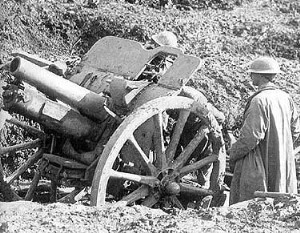 The four brigades of the West Lancs RFA spent nearly three months with the 2nd Canadian Division in the Ypres sector before being withdrawn for a period of training and then moving to join their own Territorial division now reassembling its scattered battalions in France and to be numbered as the 55th (West Lancashire) Division in January 1916. In the meantime they began to learn their battlefield gunnery and administration although the ration of shells was a rather less-than generous 50 rounds per battery per week (a single 18-pounder could fire 20 rounds a minute although the normal rate of fire was four a minute).
The four brigades of the West Lancs RFA spent nearly three months with the 2nd Canadian Division in the Ypres sector before being withdrawn for a period of training and then moving to join their own Territorial division now reassembling its scattered battalions in France and to be numbered as the 55th (West Lancashire) Division in January 1916. In the meantime they began to learn their battlefield gunnery and administration although the ration of shells was a rather less-than generous 50 rounds per battery per week (a single 18-pounder could fire 20 rounds a minute although the normal rate of fire was four a minute).
Except for the cold, which [was relieved] by the issue of stoves, life at the gun position was preferable to that of the wagon line. Here the drivers rejoiced in perpetually wet feet and were very busy – in intervals of trying to keep things clean – in carting bricks and stones to make the standings [for horses and wagons] firmer.
(Wadsworth, 1st WL RFA)
It was a wet autumn … ‘Mud is the atmosphere in which one lives and moves and has one’s being’. Elaborate instructions on standings were issued to the Brigade but little material for making them. The Ammunition Column tried experiments with brushwood and brick … the batteries, less ambitions were more successful and, by December, provided some solid ground for the horses. Then, of course, the Brigade moved.
(4th WL RFA History)
Developments included manhandling guns into the front line (across open country) to engage targets directly and, according to the official War Diaries, there was much discussion and direction from on high about the procedures to be used ‘Annoying the Enemy’, perhaps something that might be thought unnecessary given that the enemy must have been already pretty annoyed to have launched some millions of men across the French and Belgian borders. ‘Annoyance’ involved the shelling of supply routes, road junctions and various other critical points: it meant harassment.
Critically, shooting improved:
The Batteries began to gain a reputation for careful and accurate shooting. On on occasion they obtained five direct hits on a mound measuring 6 feet by 20 feet at a range of two miles. (4th WL RFA History)
Christmas was spent reasonably comfortably in the civilized back areas and with some home leave. The New Year of 1916 would bring fresh challenges and eventually much more dangerous work with the reconstituted 55th (West Lancashire) Division.
A battery of 18-pounder guns of the Royal Field Artillery moving up towards Mailly-Maillet (on the Somme) to meet the German advance, 26 March 1918. (© IWM Q 8631)
Further Reading and Sources
National Archive of Canada
-
War Diary West Lancs Divisional Artillery October-November 1915 MIKAN 2005417
-
War Diary 1st West Lancs Bde RFA October-November 1915 MIKAN 2005421
-
War Diary 2nd West Lancs Bde RFA October-November 1915 MIKAN 2005422
-
War Diary 3rd West Lancs Bde RFA October-November 1915 MIKAN 2005423
Books:
-
British Artillery on the Western Front in the First World War (Ashgate Studies in First World War History) – Sanders Marble
-
Artillery in the Great War – Paul Strong and Sanders Marble
Regimental Histories and Sources
-
War Diary of the 1st West Lancashire Brigade RFA – Capt WW Wadsworth MC
-
288 (2nd West Lancashire) Light Anti-Aircraft Regiment RA TA: A History – Captain AW Simpson RA TA
-
‘Kamp Knews’, No. 20 Christmas 1915: 3rd West Lancashire Brigade RFA - Anon
-
A Short History of the 59th (4th West Lancashire) Brigade RA TA – Colonel LM Synge TD
-
History of the 359 (4th West Lancashire) Medium Regiment RA (TA) 1859-1959
-
103rd (Lancashire Artillery Volunteers) Regiment RA(V) 1967-2001 – Colonel Frank Masters CBE TD DL
-
http://www.merseysiderollofhonour.co.uk/partinthewar/21.htm Liverpool Territorial Artillery Corps
-
http://www.merseysiderollofhonour.co.uk/partinthewar/22.htm Lancashire and Cheshire RGA and Lancashire Fortress Engineers
1 The battle honour ‘Ubique’ is also carried by the Royal Engineers. As a young infantry officer, the author was told that in the case of the Royal Artillery (RA), this meant not so much ‘Everywhere’ as ‘All over the place’
2 Wikipedia article on the 42nd (East Lancashire) Division
3 ‘Bully’ was a form of canned corned beef (from the French boeuf bouilli, meaning ‘boiled beef’).
Previous page: Territorials Attack 1915
Next page: The West Lancashire Division Reforms
